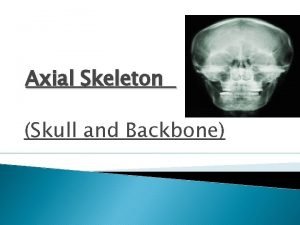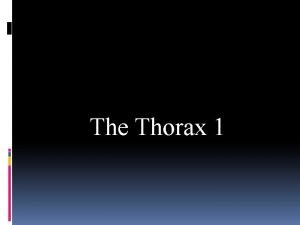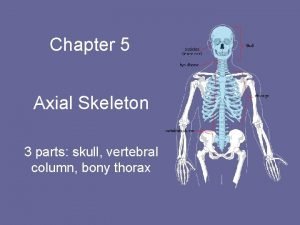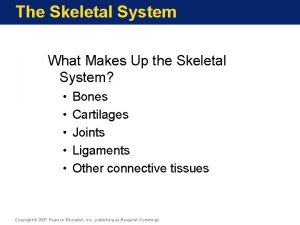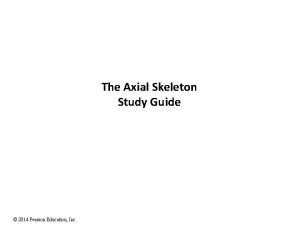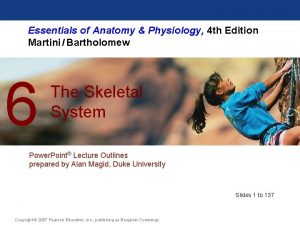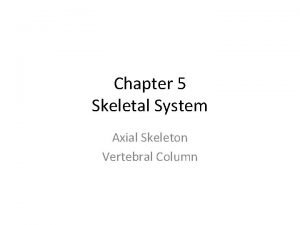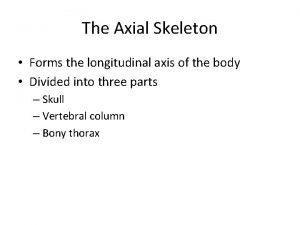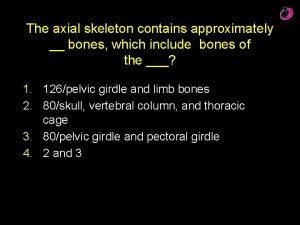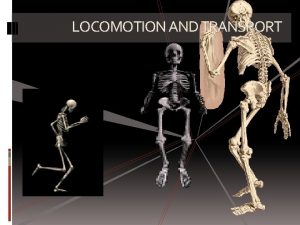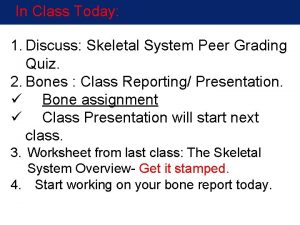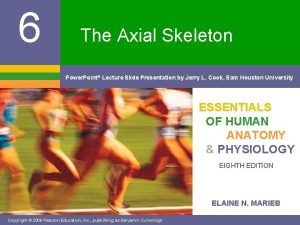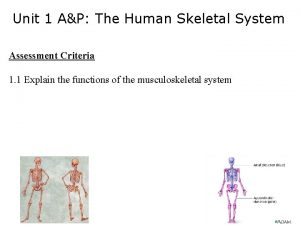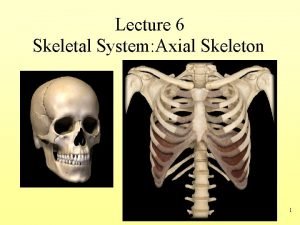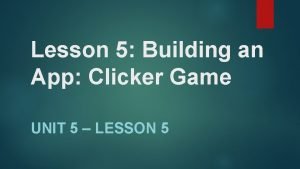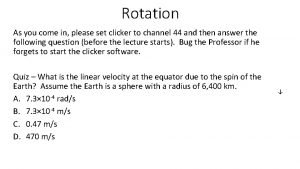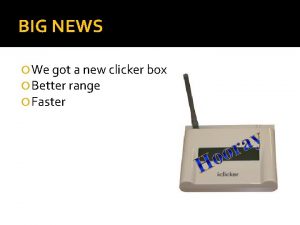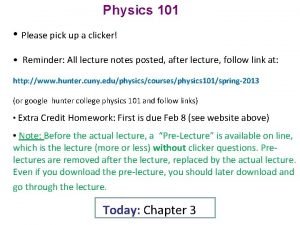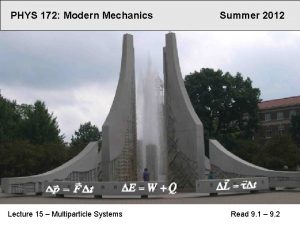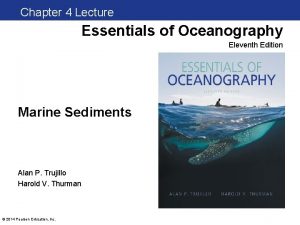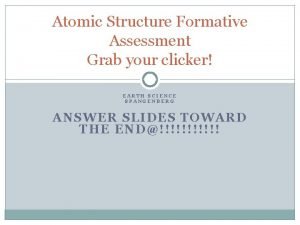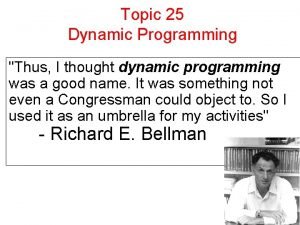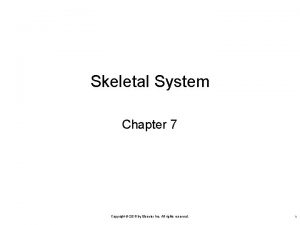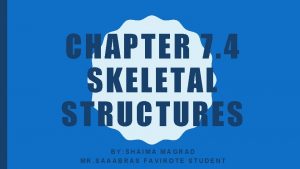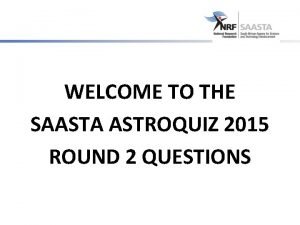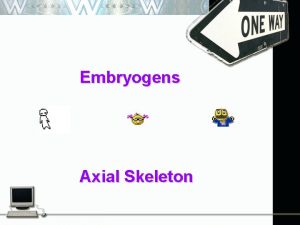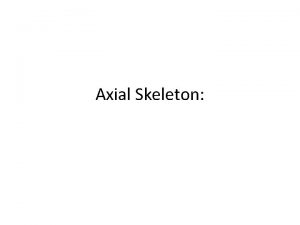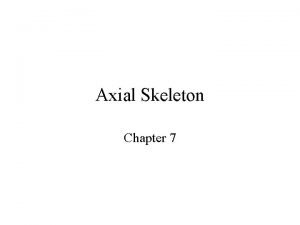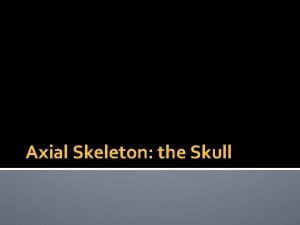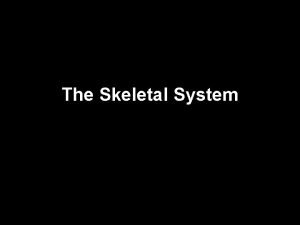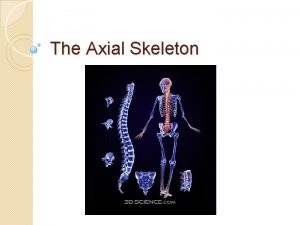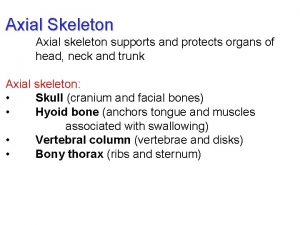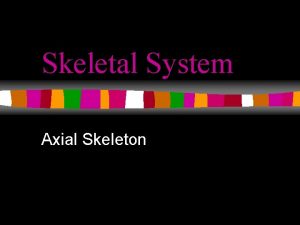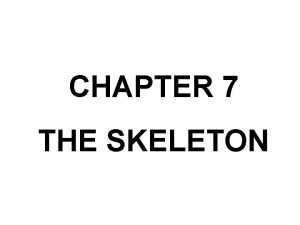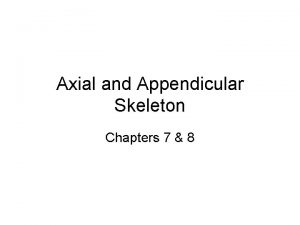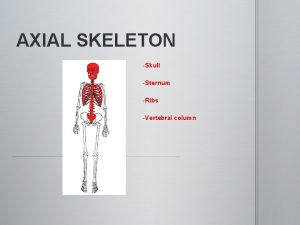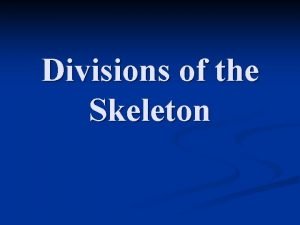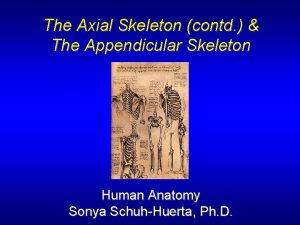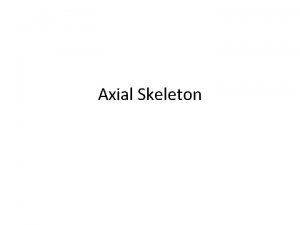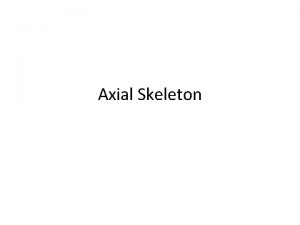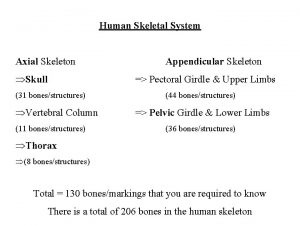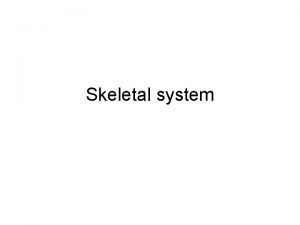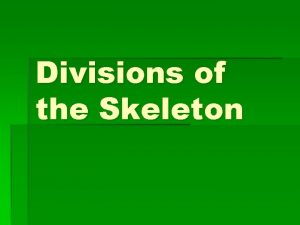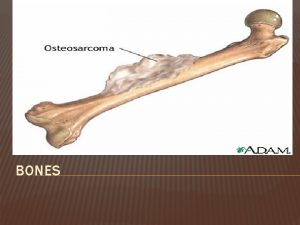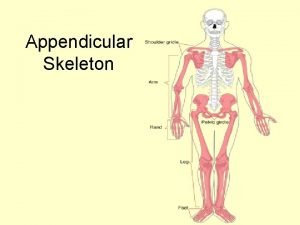Chapter 7 The Axial Skeleton Clicker Questions 2015





















































- Slides: 53

Chapter 7 The Axial Skeleton Clicker Questions © 2015 Pearson Education, Inc.

In which bone is the obturator foramen located? a. os coxa b. femur c. sacrum d. coccyx © 2015 Pearson Education, Inc.

In which bone is the obturator foramen located? a. os coxa b. femur c. sacrum d. coccyx © 2015 Pearson Education, Inc.

Which bone contains the depression that articulates with the occipital condyles? a. atlas b. axis c. temporal d. occipital © 2015 Pearson Education, Inc.

Which bone contains the depression that articulates with the occipital condyles? a. atlas b. axis c. temporal d. occipital © 2015 Pearson Education, Inc.

Which suture is NOT paired with the bones it separates? a. lambdoidal / occipital and parietal bones b. squamous / temporal and sphenoid bones c. coronal / frontal from two parietal d. sagittal / parietal bones © 2015 Pearson Education, Inc.

Which suture is NOT paired with the bones it separates? a. lambdoidal / occipital and parietal bones b. squamous / temporal and sphenoid bones c. coronal / frontal from two parietal d. sagittal / parietal bones © 2015 Pearson Education, Inc.

Which behavior is related to TMJ syndrome? a. oversleeping b. bruxism c. overeating d. anorexia nervosa © 2015 Pearson Education, Inc.

Which behavior is related to TMJ syndrome? a. oversleeping b. bruxism c. overeating d. anorexia nervosa © 2015 Pearson Education, Inc.

Paranasal sinuses serve what purposes? a. provide a superior and posterior boundary of the nasal complex b. provide the lateral and inferior boundaries of the nasal complex c. pull mucus back toward the throat d. lighten the skull bones and provide an extensive area of mucous epithelium © 2015 Pearson Education, Inc.

Paranasal sinuses serve what purposes? a. provide a superior and posterior boundary of the nasal complex b. provide the lateral and inferior boundaries of the nasal complex c. pull mucus back toward the throat d. lighten the skull bones and provide an extensive area of mucous epithelium © 2015 Pearson Education, Inc.

Jose suffers a blow to the skull that fractures his nose and breaks the nasal septum superior to the vomer. What bone is broken? a. frontal bone b. right temporal bone c. right parietal bone d. ethmoid bone © 2015 Pearson Education, Inc.

Jose suffers a blow to the skull that fractures his nose and breaks the nasal septum superior to the vomer. What bone is broken? a. frontal bone b. right temporal bone c. right parietal bone d. ethmoid bone © 2015 Pearson Education, Inc.

Which of these bones are paired bones of the face? a. temporal bones b. inferior nasal conchae c. parietal bones d. both A and C © 2015 Pearson Education, Inc.

Which of these bones are paired bones of the face? a. temporal bones b. inferior nasal conchae c. parietal bones d. both A and C © 2015 Pearson Education, Inc.

Which bone contains the mental foramen and what structures use that passageway? a. parietal; none b. occipital; hypoglossal nerves c. temporal; internal carotid artery d. mandible; mental nerves © 2015 Pearson Education, Inc.

Which bone contains the mental foramen and what structures use that passageway? a. parietal; none b. occipital; hypoglossal nerves c. temporal; internal carotid artery d. mandible; mental nerves © 2015 Pearson Education, Inc.

Which of the following are part of the ethmoid bone? a. sella turcica, middle and inferior nasal conchae, and perpendicular plate b. nasal conchae, crista galli, and olfactory foramina c. superior and middle nasal conchae, optic foramen, and optic canal d. None of the above are correct. © 2015 Pearson Education, Inc.

Which of the following are part of the ethmoid bone? a. sella turcica, middle and inferior nasal conchae, and perpendicular plate b. nasal conchae, crista galli, and olfactory foramina c. superior and middle nasal conchae, optic foramen, and optic canal d. None of the above are correct. © 2015 Pearson Education, Inc.

The significance of the petrous part of the temporal bone is that it serves as ____. a. the housing for the auditory ossicles b. a passage for the jugular vein c. sites of attachment for muscles that move the mandible d. the housing for the temporal sinuses © 2015 Pearson Education, Inc.

The significance of the petrous part of the temporal bone is that it serves as ____. a. the housing for the auditory ossicles b. a passage for the jugular vein c. sites of attachment for muscles that move the mandible d. the housing for the temporal sinuses © 2015 Pearson Education, Inc.

The axial skeleton contains the bones of the ___. a. pelvic girdle and limb bones b. pelvic girdle and pectoral girdle c. skull, vertebral column, and thoracic cage d. both B and C © 2015 Pearson Education, Inc.

The axial skeleton contains the bones of the ___. a. pelvic girdle and limb bones b. pelvic girdle and pectoral girdle c. skull, vertebral column, and thoracic cage d. both B and C © 2015 Pearson Education, Inc.

A structural factor that may lead to sinusitis is a. misaligned temporomandibular joint b. deviated nasal septum c. herniated intervertebral disc d. craniostenosis © 2015 Pearson Education, Inc.

A structural factor that may lead to sinusitis is a. misaligned temporomandibular joint b. deviated nasal septum c. herniated intervertebral disc d. craniostenosis © 2015 Pearson Education, Inc.

Bones of the axial skeleton have all of the following functions EXCEPT a. protect the brain and spinal cord b. provide surface area for the attachment of respiratory muscles c. contain medullary cavities with yellow bone marrow d. protect organs of the ventral body cavity © 2015 Pearson Education, Inc.

Bones of the axial skeleton have all of the following functions EXCEPT a. protect the brain and spinal cord b. provide surface area for the attachment of respiratory muscles c. contain medullary cavities with yellow bone marrow d. protect organs of the ventral body cavity © 2015 Pearson Education, Inc.

How can you distinguish between true ribs and false ribs? a. True ribs attach directly to the sternum by their own costal cartilage. b. True ribs are entirely bony. c. False ribs are not part of the thoracic cage. d. True ribs are attached only to the sternum. © 2015 Pearson Education, Inc.

How can you distinguish between true ribs and false ribs? a. True ribs attach directly to the sternum by their own costal cartilage. b. True ribs are entirely bony. c. False ribs are not part of the thoracic cage. d. True ribs are attached only to the sternum. © 2015 Pearson Education, Inc.

What is the main difference between vertebrosternal and vertebrochondral ribs? a. Vertebrosternal ribs attach to the sternum by their own costal cartilages. b. Vertebrochondral ribs’ costal cartilages fuse and merge with cartilages from rib 7. c. Vertebrosternal ribs increase in curvature and length from 1 to 7. d. All of the above are correct. © 2015 Pearson Education, Inc.

What is the main difference between vertebrosternal and vertebrochondral ribs? a. Vertebrosternal ribs attach to the sternum by their own costal cartilages. b. Vertebrochondral ribs’ costal cartilages fuse and merge with cartilages from rib 7. c. Vertebrosternal ribs increase in curvature and length from 1 to 7. d. All of the above are correct. © 2015 Pearson Education, Inc.

Kyphosis is an abnormal curvature of the vertebral column in which area? a. lumbar b. cervical c. thoracic d. sacral © 2015 Pearson Education, Inc.

Kyphosis is an abnormal curvature of the vertebral column in which area? a. lumbar b. cervical c. thoracic d. sacral © 2015 Pearson Education, Inc.

Why are the bodies of lumbar vertebrae so large? a. They develop first and therefore have longer to grow. b. to provide more flexibility c. They support more body mass than any other vertebrae. d. to provide greater protection to the lumbar spinal nerves © 2015 Pearson Education, Inc.

Why are the bodies of lumbar vertebrae so large? a. They develop first and therefore have longer to grow. b. to provide more flexibility c. They support more body mass than any other vertebrae. d. to provide greater protection to the lumbar spinal nerves © 2015 Pearson Education, Inc.

Which is the vertebra prominens? a. T 11 b. C 7 c. L 1 d. C 1 © 2015 Pearson Education, Inc.

Which is the vertebra prominens? a. T 11 b. C 7 c. L 1 d. C 1 © 2015 Pearson Education, Inc.

Joe suffered a hairline fracture at the base of the dens. Which bone is fractured, and where is it located? a. second cervical vertebra; posterior neck b. first cervical vertebra; posterior neck c. occipital bone; posterior base of skull d. sacrum; posterior pelvis © 2015 Pearson Education, Inc.

Joe suffered a hairline fracture at the base of the dens. Which bone is fractured, and where is it located? a. second cervical vertebra; posterior neck b. first cervical vertebra; posterior neck c. occipital bone; posterior base of skull d. sacrum; posterior pelvis © 2015 Pearson Education, Inc.

The secondary curves of the spine are the _______. a. lumbar and thoracic b. cervical and sacral c. lumbar and sacral d. cervical and lumbar © 2015 Pearson Education, Inc.

The secondary curves of the spine are the _______. a. lumbar and thoracic b. cervical and sacral c. lumbar and sacral d. cervical and lumbar © 2015 Pearson Education, Inc.

How many total bones are in the axial skeleton? a. 100 b. 200 c. 50 d. 80 © 2015 Pearson Education, Inc.

How many total bones are in the axial skeleton? a. 100 b. 200 c. 50 d. 80 © 2015 Pearson Education, Inc.

What feature distinguishes cervical vertebrae 2– 6 from a thoracic or lumbar vertebra? a. bifurcated spinous processes b. demifacets for the ribs c. transverse foramina d. both A and C © 2015 Pearson Education, Inc.

What feature distinguishes cervical vertebrae 2– 6 from a thoracic or lumbar vertebra? a. bifurcated spinous processes b. demifacets for the ribs c. transverse foramina d. both A and C © 2015 Pearson Education, Inc.

What is a consequence of early closure of one or more sutures? a. distorted skull shape b. brain stops growing c. water on the brain d. early death © 2015 Pearson Education, Inc.

What is a consequence of early closure of one or more sutures? a. distorted skull shape b. brain stops growing c. water on the brain d. early death © 2015 Pearson Education, Inc.

Why does the vertebral column of an adult have fewer vertebrae than that of a newborn? a. Vertebrae are absorbed as adult stature is reached. b. Newborns require more support in the cervical region. c. The sacrum and coccyx fuse post-puberty. d. Vertebrae are formed that later become ribs. © 2015 Pearson Education, Inc.

Why does the vertebral column of an adult have fewer vertebrae than that of a newborn? a. Vertebrae are absorbed as adult stature is reached. b. Newborns require more support in the cervical region. c. The sacrum and coccyx fuse post-puberty. d. Vertebrae are formed that later become ribs. © 2015 Pearson Education, Inc.

Which of these bones form parts of the orbital complex and also contain paranasal sinuses? a. sphenoid, frontal, maxillary, and lacrimal b. zygomatic, lacrimal, frontal, and palatine c. palatine, temporal, ethmoid, and zygomatic d. maxillary, sphenoid, frontal, and ethmoid © 2015 Pearson Education, Inc.

Which of these bones form parts of the orbital complex and also contain paranasal sinuses? a. sphenoid, frontal, maxillary, and lacrimal b. zygomatic, lacrimal, frontal, and palatine c. palatine, temporal, ethmoid, and zygomatic d. maxillary, sphenoid, frontal, and ethmoid © 2015 Pearson Education, Inc.

Several openings occur within the temporal bone for the passage of structures. Which of the following is correct? a. foramen magnum / medulla oblongata and hypoglossal canals / hypoglossal nerves b. hypoglossal canals / hypoglossal nerve and jugular foramen / glossopharyngeal, vagus, and accessory nerves c. foramen lacerum / small arteries and jugular foramen / jugular vein d. carotid canal / internal carotid artery and stylomastoid foramen / facial nerve © 2015 Pearson Education, Inc.

Several openings occur within the temporal bone for the passage of structures. Which of the following is correct? a. foramen magnum / medulla oblongata and hypoglossal canals / hypoglossal nerves b. hypoglossal canals / hypoglossal nerve and jugular foramen / glossopharyngeal, vagus, and accessory nerves c. foramen lacerum / small arteries and jugular foramen / jugular vein d. carotid canal / internal carotid artery and stylomastoid foramen / facial nerve © 2015 Pearson Education, Inc.
 Difference between axial and appendicular skeleton
Difference between axial and appendicular skeleton Appendicular vs axial skeleton
Appendicular vs axial skeleton Axial skeleton vs appendicular skeleton
Axial skeleton vs appendicular skeleton Chapter 5 axial skeleton worksheet answers
Chapter 5 axial skeleton worksheet answers Receive
Receive Clicker questions physics
Clicker questions physics Differentiate between axial and appendicular skeleton
Differentiate between axial and appendicular skeleton Figure 6-2 structure of a typical bone
Figure 6-2 structure of a typical bone Figure 6-4 the skeleton axial and appendicular divisions
Figure 6-4 the skeleton axial and appendicular divisions Superior view of the skull calvaria removed
Superior view of the skull calvaria removed Figure 6-4 the skeleton axial and appendicular divisions
Figure 6-4 the skeleton axial and appendicular divisions 7 12 5 spine
7 12 5 spine The axial skeleton forms the longitudinal axis of the body
The axial skeleton forms the longitudinal axis of the body The axial skeleton contains
The axial skeleton contains 5 functions of skeletal system
5 functions of skeletal system Concept map: bones of the pelvic girdle
Concept map: bones of the pelvic girdle Figure 6-4 the skeleton axial and appendicular divisions
Figure 6-4 the skeleton axial and appendicular divisions Lacrimal bones
Lacrimal bones C1 vertebrae name
C1 vertebrae name Sadpam
Sadpam Axial skeleton
Axial skeleton Math clicker
Math clicker E clicker
E clicker +audience +response +clicker
+audience +response +clicker Lesson 5 building an app clicker game
Lesson 5 building an app clicker game Earth clicker
Earth clicker Maximal heart rate
Maximal heart rate Japan movie rape
Japan movie rape Clicker stop motion
Clicker stop motion Cooi clicker
Cooi clicker Umbc clicker
Umbc clicker Clicker box
Clicker box Roger rabbit
Roger rabbit Clicker stop motion
Clicker stop motion Clicker
Clicker Phys 172
Phys 172 Buzka clicker
Buzka clicker Salt clicker
Salt clicker Clicker gravel transport
Clicker gravel transport Atomic clicker
Atomic clicker Touch the spacebar
Touch the spacebar Fibonacci clicker
Fibonacci clicker Clicker
Clicker Presentation clicker challenger
Presentation clicker challenger Sohcahtoa practice
Sohcahtoa practice A physical change occurs when a peach spoils
A physical change occurs when a peach spoils Evolutionary history
Evolutionary history Chapter 7:4 skeletal system label the skeleton
Chapter 7:4 skeletal system label the skeleton 7:4 skeletal system
7:4 skeletal system Astro quiz round 2
Astro quiz round 2 Astroquiz round 1
Astroquiz round 1 2015 dse english reading
2015 dse english reading Hát kết hợp bộ gõ cơ thể
Hát kết hợp bộ gõ cơ thể Lp html
Lp html

